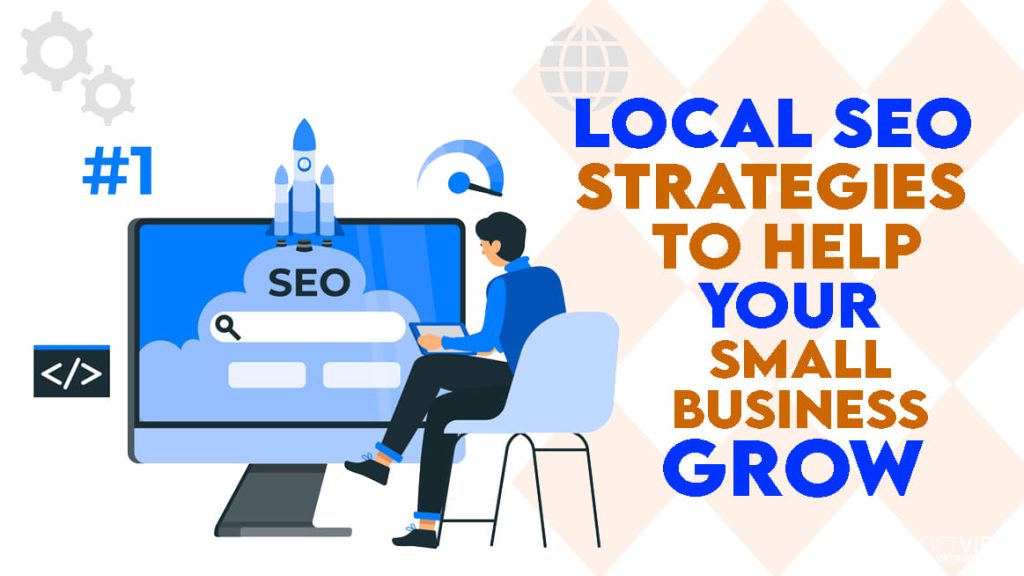Local SEO is a type of digital marketing that helps local businesses reach their potential customers using search engines such as Google. When people in your area are looking for the items or services you provide, you’ll need your business to show up in search results, and having a local SEO plan can help you do that.

Since the technique is more relevant to your local customer base, improving your local SEO implies more website traffic, leads, and conversions. Consider this concentrated strategy as a technique to help you compete more successfully against larger large businesses with unlimited resources to invest. By focusing on particular local-SEO tasks, you can counter the advantage of larger businesses that frequently optimize for broader keywords and depend on brand awareness rather than value propositions to drive traffic.
To know more, here are the top ten ways to succeed with local SEO.
What is Local SEO?
Local SEO (Search Engine Optimization) is increasing search engine exposure for local businesses, particularly those with a physical presence. Businesses can increase organic traffic from consumer searches in neighboring locations by keeping to local SEO best practices.
Search engines depend on signals like local content, social profile pages, links, and references to gather information for local search to offer the most relevant local results to the user,
Businesses can utilize local SEO to put their products and services in front of local prospects and consumers looking for them.
10 Important Factors for Succeeding at Local SEO
- Create Google My Business Account
Optimizing your Google listing is currently the most efficient technique to rank higher on Google Maps and increase local search results exposure.
However, to access your Business Profile and make these changes, you should have a Google My Business account connected to that profile. When you provide all the needed information in your Google My Business account dashboard, it will be published to your Business Profile, which will display in Google Search local results, Google maps and Google Search Knowledge.
- Optimize for Voice Search
In the future years, voice search will soar. Therefore, optimizing how people ask inquiries while speaking into devices is essential rather than how people type out their queries in local SEO.
When conducting voice searches, your customers use more long-tail terms than regular search queries. As a result, you’ll need to change the SEO of your content to suit the more conversational tone of someone speaking. For instance, you’ll need to account for the standard question starters (who, what, when, where, why, and how).
When optimizing for voice, it’s also critical to consider user intent, as these searches are typically made when the user needs a specific piece of information. Customers want a quick and helpful response when they ask Alexa to convert teaspoons to cups while baking. If a potential customer uses voice search to inquire about your business’s hours, this information should be easily accessible.
- Get regular reviews from Satisfied Customers.
Allowing your customers to write positive reviews for your business not only improves your Google My Business profile but also encourages additional local customers to buy from you. BrightLocal’s 2017 Local Consumer Review Survey shows that 85% of buyers trust online reviews more than personal recommendations.
Here are some ideas to get customers to submit reviews:
- After a transaction, request a personal review.
- Send a post-purchase email or text inviting customers to submit a review (but only after you’ve screened them using an internal poll to ensure you’re not targeting unsatisfied customers).
- Respond to existing reviews responsibly, thanking reviewers and resolving problems in negative reviews.
- Assure that your name, contact, and business address are consistent online
It would be best if you made it simple for people and search engines to discover you. Set up your NAP for name, address, and phone number to do this (with area code). It should be included on your site as crawlable HTML text.
Avoid only including the NAP within an image; unlike HTML text, search engines cannot crawl images. The NAP is most commonly seen in the site’s footer or header.
- Optimize your website for Mobile
People are more exploring the web on their phones than ever before, so if your website operates effectively on mobile devices, you’ll gain a lot of traffic and income. As a result, many businesses have assured that their websites offer a mobile-friendly version.
Aside from that, Acquisio research has revealed that many local mobile searches result in an in-person visit to a business. As a result, if you do not optimize your website to be mobile-friendly, you will lose money.
Your SEO may suffer if you’re not designing your website to be mobile-friendly, mainly because Google uses mobile-first indexing.
Mobile-first indexing means that Google will prioritize indexing the mobile version of your website above the desktop version. So, if your website doesn’t operate effectively on mobile browsers, mobile-friendly versions may acquire more visitors and be ranked higher than yours. Your SEO may suffer if you have not configured your website to be mobile-friendly, primarily since Google uses mobile-first indexing.
- Improve your internal linking structure
Although external links to your website are preferable, altering your institutional management structure will improve your SEO rankings.
Why does internal linking matter? It does the following:
- Helps with website navigation
- It contributes to the data architecture and structure of the website.
- The authority and ranking power of individual pages are shared across all pages.
- Make sure you have a great URL, title tags, headers, meta description, and content material.
Regarding content, each new blog post represents a new indexed page for your site, a new page on which to target a geographic search term, and a new chance to appear in search engine results pages.
Every time you create new content, you should optimize it for search engines by using high-volume keywords in the URL, title, header, meta description, and body. If you need help coming up with geo-targeted content, consider emphasizing customer success stories and case studies.
- Make sure your website is mobile-friendly
Local and mobile searches go hand in hand (61% of all Google searches are performed on Mobile).
Some of the most common ways visitors may use your site in a mobile context are to seek reviews, discover directions to your location, and search for contact information. In fact, “near me” mobile searches have surged by 250% since 2017.
Make it simple for your prospects and consumers by making your website mobile-friendly.
- Create local content.
Google has become more innovative, meaning content providers may write for consumers rather than search engines. While blogging about general issues can draw a large audience, it is often more necessary to focus on your target and write about local or business news to attract a local audience.
Promote local industry meetings, news, employees, and other instructive content on your blog to promote yourself as the local expert in your sector. Explore top-of-funnel content that goes beyond what your business provides.
- Participate in your local community
The more you become involved in the community, the more digital PR you’ll get. Establishing a volunteer day at your business, sponsoring an event (even an online one), or appearing in the local media as an authority in your sector are all methods to generate press, brand recognition, and inbound links.
Final Thoughts
SEO is growing at a quick pace. You never know when Google will add new features to its SERPs for local searches, but you can rely on these updates. That’s why it’s critical to always keep on top of local SEO. Adopting these ten actionable actions will ensure that your business benefits from profitable local searches and has a solid foundation when new SEO capabilities are implemented.
But proceed cautiously. There is no need to hurry. Ensure you understand what you’re doing so your site’s SEO is smooth. And, if needed, engage with professionals who have experience generating outcomes through site search engine optimization. Also, for better SEO quality, you can back up and buy computer software
that may help your business.
AUTHOR:

Jennysis Lajom is an IT graduate, a chemist, an eCommerce business owner, and a Korean drama fan. Her passion for digital marketing led her to a career in graphic design, editing, and social media marketing. She is also one of the resident SEO writers in the Softvire US and Softvire Australia.
